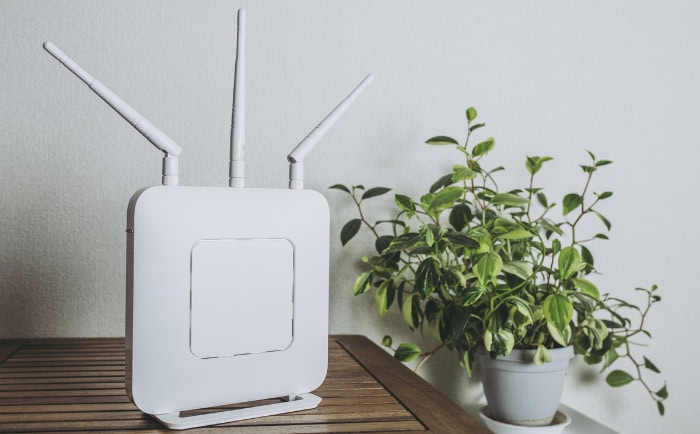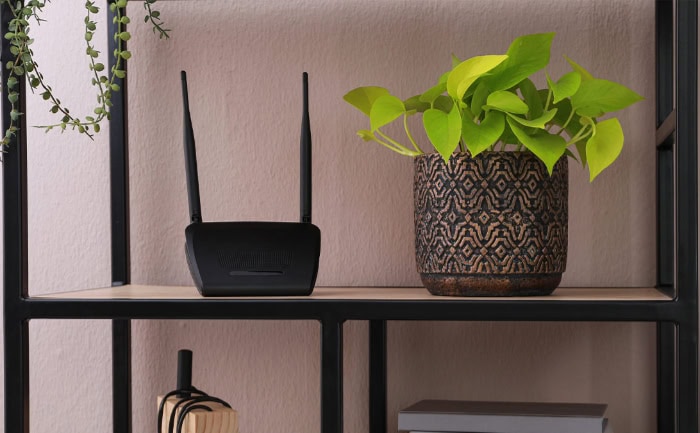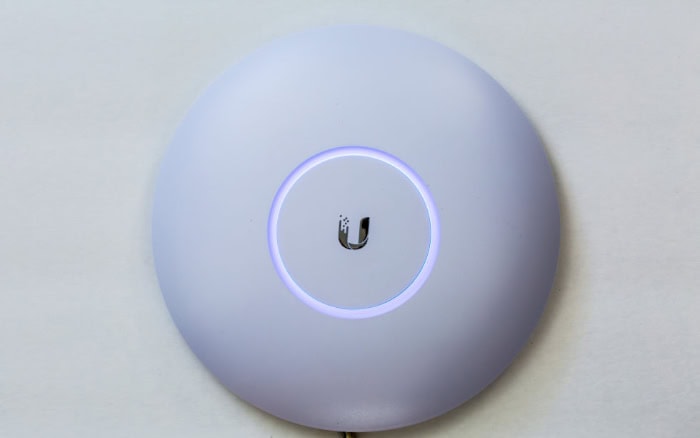How to Hide WiFi Router: 4 Stylish Solutions for Your Home

Your Wi-Fi router is an essential piece of technology, but let’s face it—it’s not exactly a work of art. That clunky, antenna-clad device can easily become an eyesore, clashing with your carefully curated home decor. However, hiding your router isn’t just about aesthetics; proper placement is crucial for maintaining a strong, reliable wireless signal throughout your space.
Disguising Your Router in Plain Sight
If you’re looking for a quick and easy way to hide your Wi-Fi router without much effort, disguising it in plain sight might be the perfect solution. By blending your router into your existing decor, you can keep it easily accessible for maintenance and troubleshooting while minimizing its visual impact on your space.
Hollowed-Out Books and Vintage Book Covers
One clever way to conceal your Wi-Fi router is by placing it inside a hollowed-out book or an attractive vintage book cover. This method works particularly well if you have a bookshelf or a stack of books in the same room as your router.
To create a hollowed-out book, choose a hardcover book that’s large enough to accommodate your router, then carefully cut out the interior pages, leaving about a 1-inch border around the edges. Place your router inside the book, ensuring that there’s enough space for ventilation, and position it on your shelf or table.
Alternatively, you can use a decorative vintage book cover to encase your router, giving it a charming, antique appearance that complements your decor.
Decorative Boxes, Baskets, and Bins
Another easy way to disguise your Wi-Fi router is by placing it inside a decorative box, basket, or bin that matches your room’s aesthetic. Choose a container that’s large enough to house your router comfortably, with sufficient ventilation to prevent overheating.
Opt for a box with a lid or a basket with a removable cover to allow easy access to your router when needed. You can find a wide variety of stylish storage solutions at home decor stores or online retailers, making it simple to find a container that seamlessly blends with your existing furnishings.
Concealing Among Decorative Objects
If you prefer a more subtle approach, consider concealing your Wi-Fi router among other decorative objects in your room. Place your router behind a group of plants, vases, picture frames, or other accessories that can help mask its appearance.
Experiment with different arrangements until you find a setup that effectively hides your router without compromising its performance.
Mounting Your Router Out of View
If you’re willing to invest a bit more time and effort into concealing your Wi-Fi router, mounting it out of view can be an effective solution. By placing your router on a wall, ceiling, or behind furniture, you can keep it hidden from sight while still maintaining a strong and reliable wireless signal.
Wall or Ceiling Mounting
One popular method for hiding your Wi-Fi router is to mount it on a wall or ceiling. This approach works well if you have a router with detachable antennas that can be positioned vertically for optimal signal strength.
To conceal your wall-mounted router, consider placing artwork or a decorative clock in front of it. Ensure that the chosen decor item is not too thick or dense, as this may interfere with the router’s performance. When mounting your router on the ceiling, opt for a location near the center of your room to ensure even signal distribution.
Tucking Behind Furniture
Another simple way to keep your Wi-Fi router out of sight is to tuck it behind furniture, such as a couch, bookshelf, or cabinet. This method is particularly useful if you have a router with built-in antennas that can’t be detached or repositioned.
When choosing a location, ensure that the furniture item is not too close to the router, as this can obstruct the signal and cause performance issues. Additionally, consider the proximity of the router to power outlets and ethernet ports to minimize visible cabling.
In-Wall Cable Management
For a truly seamless look, you can run the cables connecting your Wi-Fi router through the walls of your home. This method involves drilling small holes in your walls and feeding the ethernet and power cables through them to keep your router hidden in a closet or an adjoining room.
While this approach requires more advanced DIY skills and tools, it can result in a clean, professional appearance that eliminates visible wires altogether. If you’re not comfortable tackling this project yourself, consider hiring a professional installer to ensure proper cable management and minimize damage to your walls.
Mounting Methods and Cable Management
When mounting your Wi-Fi router, it’s essential to choose the appropriate hardware and follow the manufacturer’s instructions carefully. Use wall anchors or toggle bolts to secure the mounting bracket to your wall or ceiling, ensuring that it can support the weight of your router.
If you’re running cables through walls, be sure to use fire-rated wall plates and properly seal any holes to maintain your home’s structural integrity and energy efficiency.
Concealing Your Router in Furniture

If you’re looking for a more permanent solution to hide your Wi-Fi router, consider integrating it into your furniture. This approach not only keeps your router out of sight but also helps maintain a cohesive and clutter-free appearance in your living space.
Entertainment Center Cabinet or Drawer
An effective option for concealing your Wi-Fi router is to install it inside an entertainment center cabinet or drawer. This method works particularly well if you have a large entertainment unit with ample storage space.
Choose a cabinet or drawer that’s close to your television or gaming console to minimize the length of exposed cables. Drill small holes in the back of the cabinet or drawer to allow for proper ventilation and cable management.
If your router has external antennas, consider using a cabinet with a mesh or perforated back panel to ensure optimal signal strength.
Side Table or Ottoman with Ventilation Cutout
Another creative solution is to place your Wi-Fi router inside a side table or ottoman with a custom ventilation cutout. This approach allows you to keep your router hidden while still providing easy access for maintenance or troubleshooting.
Choose a table or ottoman with a hollow interior and enough space to accommodate your router comfortably. Cut out a small section of the furniture’s back panel or bottom to allow for proper airflow and cable connections.
You can cover the cutout with a mesh screen or decorative grille to maintain a polished look.
Hidden Behind Books or Decor on a Bookshelf
If you have a bookshelf in your living room or home office, you can easily conceal your Wi-Fi router by placing it behind books or decorative objects. This method is simple, cost-effective, and requires no permanent modifications to your furniture.
Arrange your books or decor items in a way that creates a small space for your router, ensuring that there’s enough room for ventilation. Be mindful of the thickness and density of the objects surrounding your router, as they may impact signal strength.
Periodically check your router’s performance and adjust the placement if necessary.
Furniture Placement Considerations for Optimal Signal
When concealing your Wi-Fi router in furniture, it’s crucial to consider the placement of the furniture itself. To ensure optimal signal coverage throughout your home, position the router-containing furniture piece in a central location, away from walls and large metal objects.
Avoid placing the router on the floor or in a basement, as this can significantly reduce signal strength. If your router has external antennas, orient them vertically for the best possible performance.
Remember to test your Wi-Fi signal strength in various parts of your home after installing your router in the furniture to ensure satisfactory coverage.
Ensuring Adequate Ventilation

While concealing your Wi-Fi router can greatly improve the aesthetics of your living space, it’s crucial to ensure that your router receives adequate ventilation. Proper airflow is essential for preventing overheating, which can lead to decreased performance, hardware damage, and even potential fire hazards.
Risks of Overheating in Enclosed Spaces
When you place your Wi-Fi router in an enclosed space, such as a cabinet, drawer, or box, you limit its ability to dissipate heat effectively. Routers generate a significant amount of heat during operation, and without proper ventilation, this heat can build up and cause the device to overheat.
Overheating can lead to a range of problems, including reduced signal strength, intermittent connectivity issues, and even permanent hardware damage. In extreme cases, an overheated router may pose a fire risk, especially if it’s surrounded by flammable materials.
Allowing Sufficient Airflow
To prevent overheating, it’s essential to allow your Wi-Fi router sufficient airflow. When concealing your router in furniture or other enclosures, ensure that there’s enough space around the device for air to circulate freely.
Avoid placing your router in tight, cramped spaces or surrounding it with thick, insulating materials that can trap heat. If you’re using a cabinet, drawer, or box to hide your router, consider drilling ventilation holes or installing a small fan to promote airflow.
Aim to maintain at least a few inches of clearance on all sides of the router to facilitate proper heat dissipation.
Monitoring Router Temperature and Signs of Overheating
Regularly monitoring your Wi-Fi router’s temperature can help you identify potential overheating issues before they cause significant damage. Many modern routers have built-in temperature sensors that allow you to check the device’s operating temperature through the administrative interface.
Consult your router’s manual or the manufacturer’s website for instructions on accessing this information. If your router doesn’t have a built-in temperature sensor, you can use an infrared thermometer to measure its surface temperature periodically.
Be on the lookout for signs of overheating, such as:
- The router feels hot to the touch
- The router’s performance degrades or becomes inconsistent
- The router frequently disconnects or restarts unexpectedly
- You notice a burning smell coming from the router
If you observe any of these signs, immediately remove the router from its enclosure and allow it to cool down in an open, well-ventilated area. If the problem persists, consider relocating your router to a more suitable location or investing in a router-specific cooling accessory.
Cooling Accessories for Routers in Tight Spaces
If you must place your Wi-Fi router in a tight space with limited ventilation, consider using cooling accessories to help regulate its temperature. Router cooling fans are specially designed to attach to your router and provide additional airflow, helping to dissipate heat more effectively.
These fans are relatively inexpensive and can be powered by your router’s USB port or a separate power adapter. Alternatively, you can use a router cooling stand, which elevates your router and promotes better airflow around the device.
Getting Creative with Cable Concealment
While hiding your Wi-Fi router is a great start to achieving a clean, clutter-free look in your living space, visible cords can quickly detract from the overall aesthetic. Cables running from your router to power outlets, modems, and other devices can create an unsightly tangle that draws attention away from your carefully concealed router.
Cable Management Tips
Effective cable management is essential for maintaining a tidy, professional look when concealing your Wi-Fi router. Start by gathering all the necessary cables and cords, and then use the following tips to keep them organized and out of sight:
- Cord Clips and Ties – Use adhesive cord clips or adjustable velcro ties to bundle cables together and route them along walls, furniture, or other surfaces. This helps prevent tangles and keeps cords neatly arranged.
- Cable Raceways – Cable raceways are long, narrow channels designed to conceal and protect cords. They can be easily attached to walls or baseboards using adhesive backing or mounting hardware, providing a clean, organized look.
- Labeling – If you have multiple cords running to and from your router, consider labeling each one to make it easier to identify and troubleshoot connections in the future. You can use store-bought cable labels or create your own using masking tape and a permanent marker.
Aesthetically Pleasing Cable Sleeves
If you prefer a more stylish approach to cable concealment, consider using braided or fabric cable sleeves. These sleeves wrap around your cords, providing a uniform, textured appearance that can complement your decor.
Braided sleeves come in a variety of colors and patterns, allowing you to match them to your walls, furniture, or personal taste. Fabric sleeves, on the other hand, offer a softer, more organic look that can add a touch of warmth to your living space.
Both options are easy to install and can be cut to the desired length, making them a versatile solution for hiding unsightly cords while maintaining a cohesive, intentional aesthetic.
Conclusion
Concealing your Wi-Fi router effectively combines aesthetic appeal with functional performance, ensuring your home remains both stylish and well-connected. From disguising your router in plain sight using decorative elements like hollowed-out books and attractive bins to mounting it out of view behind furniture or on ceilings, the options are diverse.
Each method offers its own set of advantages, whether it’s the ease of access and minimal alteration required by using decorative concealments or the more permanent, clutter-free environment achieved through in-wall cable management.
Additionally, integrating your router into furniture not only keeps technology discreet but also allows for creative home decor arrangements. However, it’s crucial to maintain adequate ventilation to prevent overheating, which could compromise your router’s functionality and longevity.
Effective cable management further enhances the clean look, with solutions ranging from simple ties and clips to more elaborate in-wall installations.
By applying these strategies, you can enjoy a seamless and efficient home network setup that complements your living space without sacrificing signal strength or safety. Encouraging a blend of creativity and practicality, these solutions cater to various tastes and home layouts, proving that technology and design can coexist beautifully.


